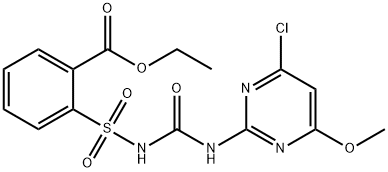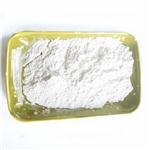Description
Chlorimuron-ethyl is a kind of post-emergence, foliar applied herbicide which is used without the EU regulatory approval. As an herbicide belonging to the sulfonylurea family, it is commonly used to control the weeds associated with wheat, rice, soybean, barley, potato, and corn. It has advantages of being broad-spectrum, having low use rate, having good crop selectivity as well as being of low toxicity to animals. Its mechanism of action is through suppressing the plant- and microbial-specific enzyme acetolactate synthase (ALS), further blocking the biosynthesis of branched-chain amino acids such as valine, leucine and isoleucine. Through this mechanism, it cause rapid cessation of plant cell division and growth.
References
http://sitem.herts.ac.uk/aeru/ppdb/en/Reports/1145.htm
http://lfse.iae.ac.cn/Article/UploadFiles/201310/2013102910313432.pdf
Chemical Properties
Colorless to off white or pale yellow crystals
or powder. Some formulations are listed as “flammable”
in the literature. Odorless.
Uses
Chlorimuron-ethyl is used in weed control method as herbicide.
Definition
ChEBI: Chlorimuron-ethyl is an ethyl ester resulting from the formal condensation of the carboxy group of chlorimuron with ethanol. A proherbicide for chloimuron, it is used as herbicide for the control of broad-leaved weeds in peanuts, soya beans, and other crops. It has a role as a proherbicide, an EC 2.2.1.6 (acetolactate synthase) inhibitor and an agrochemical. It is a sulfamoylbenzoate, a N-sulfonylurea, an aromatic ether, an ethyl ester, an organochlorine pesticide and a member of pyrimidines. It is functionally related to a chlorimuron. It is a conjugate acid of a chlorimuron-ethyl(1-).
General Description
Colorless crystals. Used as an herbicide.
Reactivity Profile
Chlorimuron-ethyl is a sulfonyl urea, and pyrimidine derivative.
Agricultural Uses
Herbicide: Used to control broadleaf weeds and annual morning glory in soybeans and peanuts. Not listed as registered for use in EU countries. Registered for use in the U.S., except California. There are more than 25 global suppliers.
Trade name
AUTHORITY®; CANOPY® (chlorimuron-ethyl + Metribuzin); CLASSIC®; CONCERT® cancelled; DPX-F6025®; GEMINI®[C]; LOROX®[C]; PREVIEW®[C]; RELIANCE®; SKERMISH®, cancelled; SYNCHRONCY®; SYNCHRONY®[C]
Potential Exposure
A sulfonylurea/pyrimidine derivative
herbicide used to control broadleaf weeds and annual morning glory in soybeans and peanuts. Not listed as registered
for use in EU countries. Registered for use in the United
States and available from more than 25 global suppliers.
Metabolic pathway
Excised soybean seedlings rapidly metabolize 14C-
chlorimuron ethyl, but common cocklebur and redroot
pigweed, which are sensitive to chlorimuron ethyl,
metabolize much more slowly. Two metabolites are
primarily identified. By intact corn seedlings,
chlorimuron ethyl undergoes biotransformation to give
more metabolites and under UV light is photodegraded
into smaller fragments.
Shipping
UN3077 Environmentally hazardous substances,
solid, n.o.s., Hazard class: 9; Labels: 9-Miscellaneous hazardous material, Technical Name Required.
Incompatibilities
Incompatible with oxidizers (chlorates,
nitrates, peroxides, permanganates, perchlorates, chlorine,
bromine, fluorine, etc.); contact may cause fires or explosions. Keep away from alkaline materials, strong bases,
strong acids, oxoacids, epoxides, nitrates.
Waste Disposal
Do not discharge into drains
or sewers. Dispose of waste material as hazardous waste
using a licensed disposal contractor to an approved landfill.
Consult with environmental regulatory agencies for guidance on acceptable disposal practices. Incineration with
effluent gas scrubbing is recommended. Containers must be
disposed of properly by following package label directions
or by contacting your local or federal environmental control
agency, or by contacting your regional EPA office.




